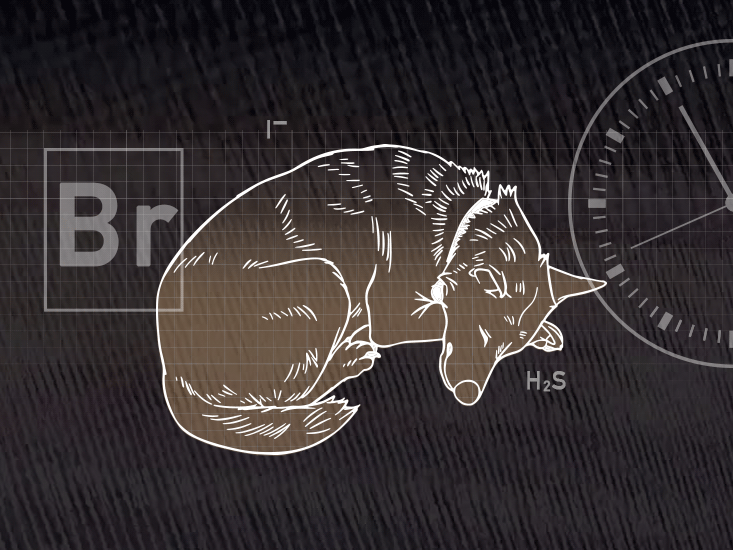The bags are packed, the car is loaded, and the neighbor will pick up the mail. Now there’s just one last thing to do before heading out the door for vacation: It’s time to turn off the dog.
You lead Sparky to his fluffy bed inside a small chamber filled with a continuous stream of hydrogen sulfide gas. While you’re away, he’ll stay—completely still. No breath. No pulse. But Sparky’s neither sleeping, nor dead. He is in a state of suspended animation, as if you simply put his body on pause. And when you return home, he’ll reboot back to normal in the fresh air.
This slightly unnerving scenario belongs to Mark Roth, a biomedical scientist at Fred Hutchinson Cancer Research Center in Seattle, Washington. The good-natured Roth offers it not as a business plan for futuristic pet care, but as an example of how suspended animation, a process in which he specializes, may work.
Roth’s real aim is to create life-saving medical procedures that would improve recoveries from heart attacks or decrease the collateral tissue damage caused by tumor irradiation. “I think the beginning is not pets on the weekend; it’s the heart attack you’re having right now,” he says. Right now his primary goal is to prove that suspended animation offers “irrefutable benefits for people who would otherwise be dead.”
The ability to go into suspended animation lies in the body’s metabolic functions, namely in the process of our cells burning energy, says Roth, who won a 2007 MacArthur “genius” award for his research. Animals need food and oxygen. When you eat a donut, for example, your cells burn sugar and oxygen. That generates energy and produces water that you expel as urine and sweat, and carbon dioxide that you exhale.
Roth has found a way to slow down the body’s metabolic burning processes by lowering the amount of oxygen a person requires. The key, he’s discovered, is what he calls Elemental Reducing Agents (ERAs)—compounds normally present in the body in small concentrations, which in greater amounts can slow down the cells’ oxygen burning. For people teetering on the brink of life and death, these ERAs may slow down their dying to the point that they could recover.

Roth began experimenting with ERAs in the early 2000s, when he tested the use of hydrogen sulfide—the poisonous gas most associated with the smell of rotten eggs—on mice. His idea was based on what he knew about certain caves in Mexico, which emitted vast amounts of hydrogen sulfide. Spelunkers who didn’t wear special protective gear experienced a “knockdown” in the caves; they became unconscious until they were moved into fresh air.
Getting his hands on some hydrogen sulfide was no easy task in the post-9/11 era. Not only is the gas poisonous, but it is also explosive, so Homeland Security paid him an unexpected visit. But once Roth was clear to proceed, he soon demonstrated that exposing mice to 80 parts per million of the gas mixed at room temperature made it possible to create a reversible suspended animation, with no evidence of harm to the animals. The feat was considered a scientific breakthrough with promising implications in treating trauma, stroke, cancer, and other conditions, and led to his MacArthur award.
“You’re dancing around with something that’s freakishly toxic,” says Roth. “I mean, you’re talking about sulfide, it’s as toxic as cyanide.” But in patients with life-threatening conditions such as cardiac arrest, for example, ERAs can prevent cell death.
Here’s how they work. When an artery becomes clogged, depriving heart tissue of oxygen, surgeons typically perform balloon angioplasty as a means of releasing the block and restoring blood flow to the heart. With the logjam broken, cells’ oxygen consumption skyrockets to a considerably higher degree than prior to the heart attack, a phenomenon known as reperfusion injury. As heart cells burn oxygen excessively, they become damaged and die. Roth wants to prevent the heart from metabolizing itself to death. By infusing patients with the ERA agents, he can let their heart cells return to normal work slowly. “It’s like a dimmer switch,” he says. “The regulation of animation tends to improve outcome.”
There are dangers involved with his research. Not only is he doing the tango with toxic compounds, but there is the very real risk of overdosing patients.
In addition to hydrogen sulfide, Roth discovered two more ERAs—bromide and another element, which is still under embargo. Both are dangerously poisonous in large amounts but naturally found in humans and other living creatures. He thinks that ERAs are the natural means by which we regulate our state of animation. “I think they’re how we regulate—because you sleep and you get up and run around the track; you sit quietly reading a book,” Roth says. “You’re kind of hibernating and being more animated at various times, and I think the ERAs are what makes it possible to engage in that sort of behavior.”
Current research into suspended animation builds upon hundreds of years of science that began in the 1660s with chemist Robert Boyle using carbon dioxide to alter the state of animation in honeybees. In the 1820s, physician Henry Hill Hickman found that carbon dioxide and nitrogen oxide could make it possible to painlessly amputate animals’ limbs. At the time, his contemporaries deemed his theories “surgical humbug,” but after his death, Hickman was declared one of the fathers of modern anesthesiology, now used for everything from root canals to cancer care.
“As a scientist, I’m no different from Boyle or Hickman, or whoever, attempting to understand the full range of animation,” Roth says. But he aims to go beyond reducing pain and consciousness. He wants to perfect the means by which it’s possible to let a person nearly die, treat them for a serious injury, then bring them back to life—Frankenstein style.
There are dangers involved with his research. Not only is he doing the tango with toxic compounds, requiring the need to be extremely vigilant about safety and security in his lab, there is the very real risk of overdosing patients. The therapeutic limits of the three ERAs are extremely narrow—give a person too much and the outcome could be lethal. But there’s some good news. In his 2014 study, published in PLoS One, Roth reports his discovery of a much safer ERA, iodide—the common ingredient in table salt—that has the full potential of the others with about 1,000 times less risk. “I like iodide for obvious reasons,” Roth says. “It’s safer to use.”
Since the beginning of his research, Roth has always paid special attention to miraculous near-death experiences that might provide some window into the world of suspended animation, like the 16-year-old boy who traveled inside the wheel well of a plane flying from Los Angeles to Hawaii last year. The teen was exposed to extreme cold, and deprived of oxygen at high altitude, yet when the plane touched down he stumbled onto the tarmac, dazed but alive. “I’ve been a student of near-death experiences for a while now,” Roth says. “There’s a huge number of these kind of examples. And that particular issue around the anecdotal capacity for people to be suspended is, I think, the place where we will learn the most as we embrace this aspect of metabolic flexibility.”
Do near-death survivors like the 16-year-old (or even hibernating bears) have higher levels of ERAs in their blood? Roth says he would love to know the answer to that question, but it’s not what he’s attempting to accomplish right now. He’s full-steam-ahead trying to figure out how ERAs function in order to build the medical utility: A “field of dreams,” he says, that can save lives.
He knows that buy-in won’t be easy, as it contradicts the Hippocratic Oath. “You’re talking about giving up vital signs—breathing, heartbeat. It tends to freak people out,” Roth says. He’s working on changing that fundamental mindset and making medics recognize the advantages of altering metabolic flexibility for certain procedures. He is about to enter human trials with hydrogen sulfide, which he’ll test in a controlled hospital setting, administering it intravenously, similar to the way anesthetics are used. He predicts that it will take up to a decade and about $100 million in research and development to take ERAs from theory to pharmacy, but he expects that one day they will be considered an ethical, normal necessity. “People go to school to become anesthesiologists,” he says. “Maybe people can become ERA-ologists in another 40 years.”
While Roth’s ambitions for suspended animation center on clinical applications, he doesn’t deny it may one day fulfill our sci-fi fantasies. “Eventually we will use it to experience environments we currently don’t experience—underwater, space—and do that more frequently because we know how,” he says. “There’s no end to the possibilities that could affect society.”
Rene Ebersole writes and edits articles and books related to science, the environment, and health. She is the staff features editor at Audubon Magazine. @rebersole


























